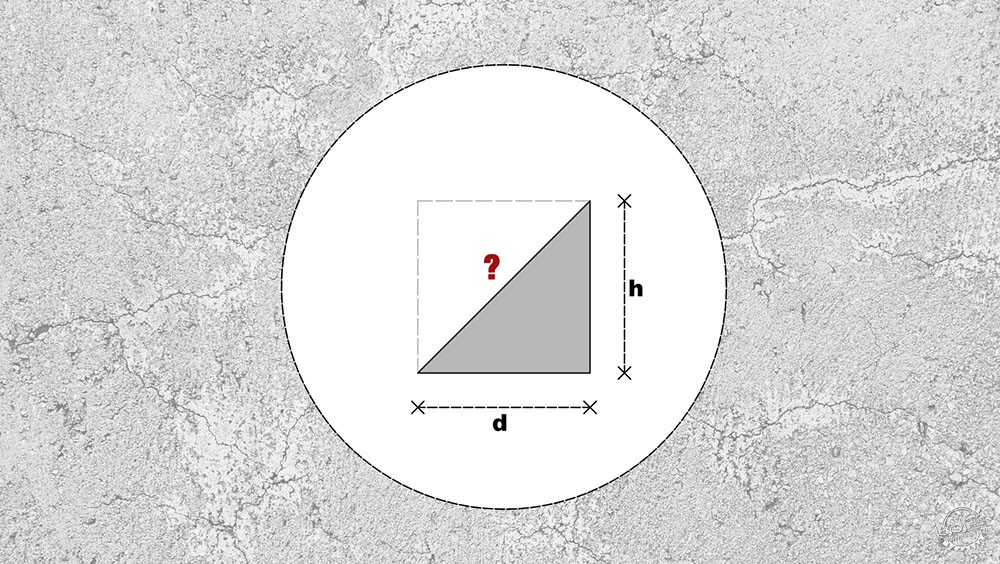
© Fabián Dejtiar
如何设计与计算坡道?
How to Design and Calculate a Ramp?
由专筑网李韧,吴静雅编译
人们都知道,除了具体的功能用途,坡道一般主要用作城市与建筑中的无障碍设施。
坡道一般由具有特定角度连续倾斜的表面组成,但其中也包含许多构造规范,也与建筑主体的具体功能相关。下文列出的是关于通用坡道尺寸的计算方法,属于普遍适用的范围。
那么,坡道的坡度应该如何计算?人们如何根据功能需求来计算坡道宽度?扶手的设计应该考虑哪些因素?在这里,小编为大家总结了坡道计算方式与实例。
We already know that the ramp, aside from its different design possibilities, allows—without forgetting the notion of promenade architecturale—its users to overcome physical barriers in the urban and architectural context.
Although it basically consists of a continuous surface with a particular angle of slope, it is necessary to point out the many constructive specifications, which of course may vary due based on the standards of different governing bodies. The following clarifications are intended to assist and determine the appropriate dimensions for comfortable and efficient ramps for all, based on the concept of universal accessibility.
To what extent can the slope of a ramp be modified? How can we determine its width and the space needed for maneuvering? What considerations exist regarding the handrails? Here we review some calculations and design examples for different ramps, below.
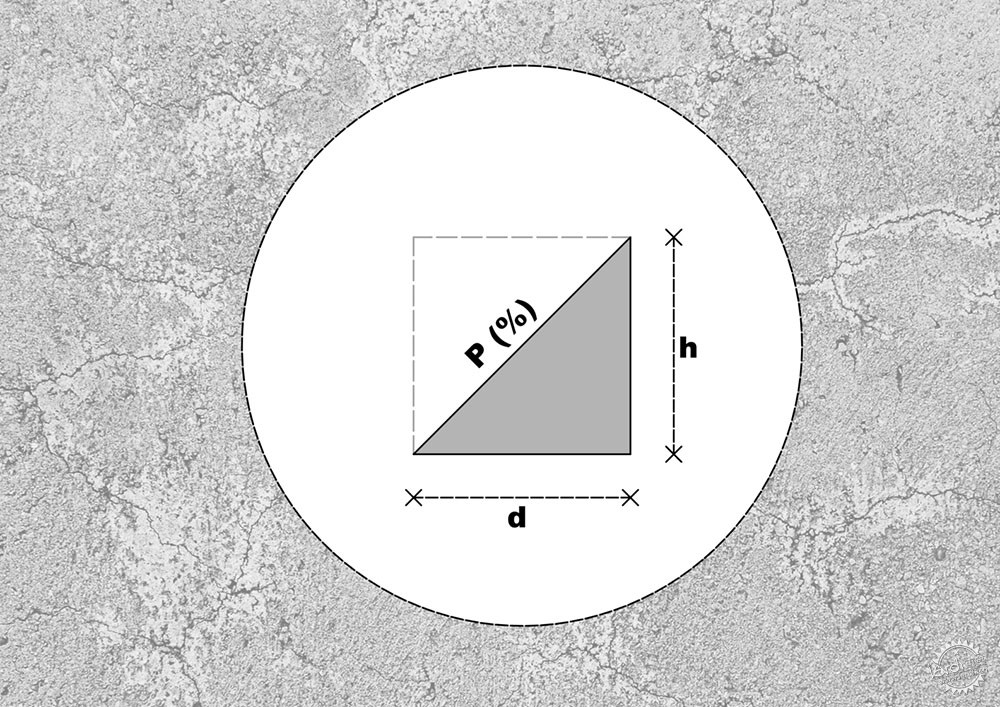
© Fabián Dejtiar
怎么计算坡道的坡度?
坡度是高度(H)和平面长度(D)的比值。
坡度=(h/d) x 100%
从这个等式中,我们可以计算出其中的未知数值,例如坡道高度为1米,平面长度为10米,那么坡度就是10%。
因此,在项目中,我们需要知道坡道两端的高差,这样才能便于计算。
How is the Slope of a Ramp Calculated?
The slope can be expressed as a percentage that results from the ratio between the height to be overcome (h) and the length of the horizontal plane (d), multiplied by 100.
Slope expressed as a percentage = (h/d) x 100
From this expression, we can solve for the unknown values of each term. An existing ramp of 1 meter in height with a horizontal distance of 10 meters, will have a slope of 10%.
Accordingly, knowing the height to overcome on a project allows us to review recommendations for a slope consistent with the required needs.
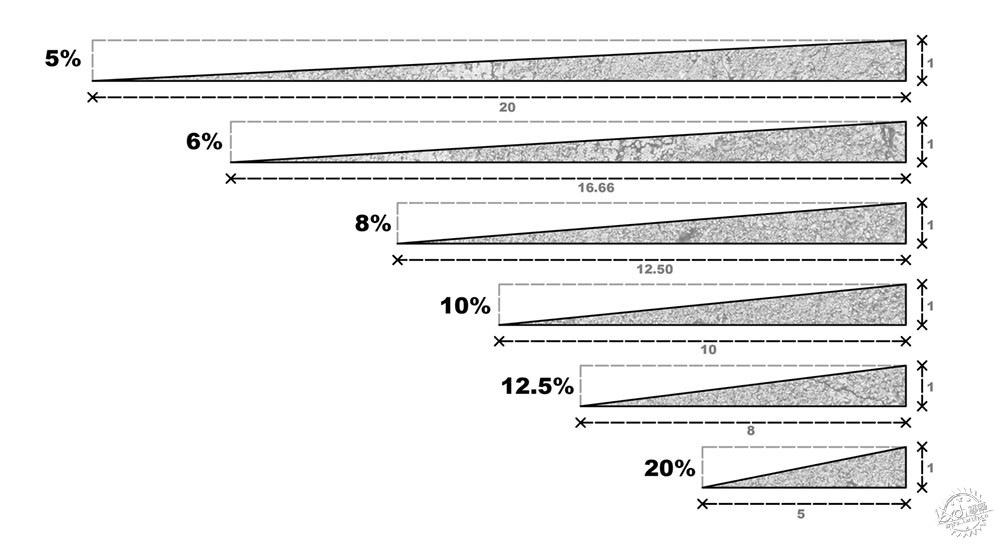
© Fabián Dejtiar
室外坡道计算实例
户外坡道的坡度与高度和平面长度有关,但是这与每个国家常用的平均值也有关系,例如拉丁美洲的建筑法规,介于10%-12%之间的坡度只能用于高度值很小的坡道,例如20厘米。因为随着高度的增长,其坡度也会相应改变。例如50厘米的高度,也许坡度会达到8%,而100厘米的高度,坡度则为6%,100厘米则对应5%,而老年人所使用的坡道坡度为4%。
而至于坡道的平面长度,例如1.5米这样较短的距离,其坡度则会小于12%,而3米,则对应的最大值为10%,9米则对应8%,并且要结合上诉的高度综合考量。
在坡道的设计中,应该每隔一段长度设置一个休息平台,因为如果没有外力的帮助,轮椅很难持续上坡,因此最大平面长度为9米。
A Schematic Example for an Outdoor Ramp
The recommended maximum slope for outdoor ramps can be established in relation to the height to be overcome and depends on the length of the plane. Based on averages and considerations from different countries -both regulatory and from manuals from Latin America—a slope of between 12-10% can, for example, be used only for very small heights, such as a step of up to 20 centimeters. As the heights require greater efforts, the slopes begin to reduce to reach recommendable values of 8% for heights of up to 50 centimeters; 6% for heights of up to 100 centimeters; 5% for heights of up to 150 centimeters; and 4% for ramps being used by the elderly.
In relation to the length of the ramp, for short distances—up to 1.5 meters—the slope should be less than 12%. For distances of up to 3 meters it must be less than 10%, and for distances of up to 9 meters, it should be less than 8%, always taking the above considerations regarding height into account.
The ramps should not have an excessive length without breaks—a maximum length of 9 meters—due to the efforts required to ascend without help in a wheelchair, or the force needed to transport heavy cargo.
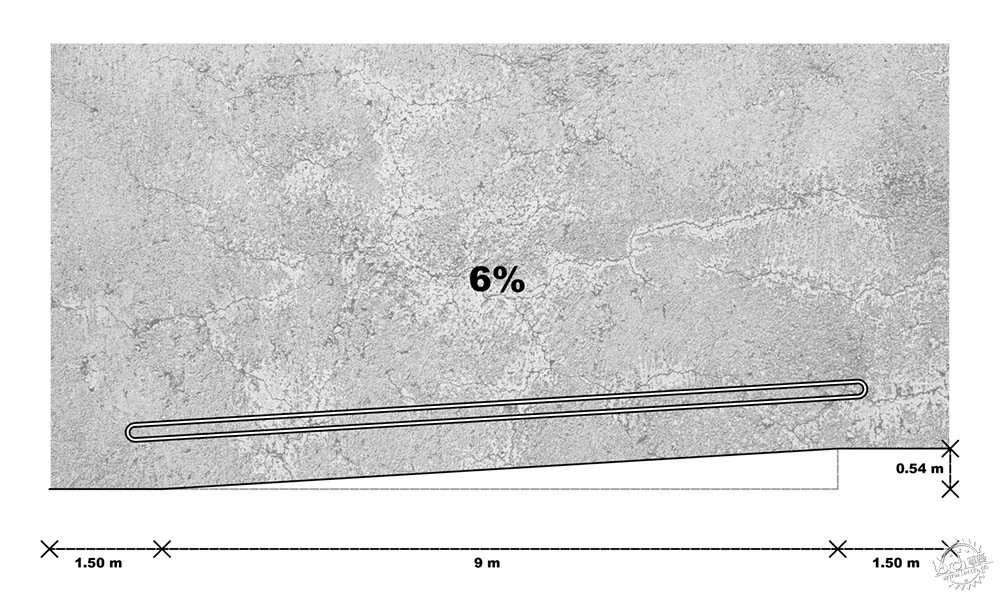
© Fabián Dejtiar
计算所需距离(d)的实际案例
例如,如果要上升54厘米,我们会选择使用6%的坡度,通过以下计算得出9米的水平距离。
6 = (0.54m / d) x 100
d = 0.54m / 0.06
d = 9 meters
室内坡道示意图
同理,坡度为10%的室内坡道的上升高度也非常小,大约为30厘米。那么,如果要达到75厘米的高度,那么坡度则应该为8%,150厘米则对应6%,老年人使用坡道的坡度则为5%。
就坡道平面长度而言,10%的坡道距离为3米,8%的坡度则适用于3米至6米的长度,而6米至9米的坡道则对应6%,同时也要结合高度进行考量。
An Example of the Calculated Distance Required (d)
As an example, to overcome a height of 54 centimeters, we will use a slope of 6%, which results in a horizontal plane of 9 meters.
6 = (0.54m / d) x 100
d = 0.54m / 0.06
d = 9 meters
A Schematic Example for an Indoor Ramp
Likewise, the percentages for the slopes of interior ramps allow for a 10% slope only to overcome very small heights, such as a step of up to 30 centimeters. Again, as the heights require greater efforts, the slopes are reduced to reach, for example, 8% for heights that go up to 75 centimeters; 6% for up to 150 centimeters; and 5% for the elderly.
Regarding the length of the ramps, for short distances—up to 3 meters—the slope should be less than 10%. For medium distances—between 3 and 6 meters—the slope should be less than 8%, and for distances between 6 and 9 meters, the slope must be less than 6% (also taking into account the previous recommendations regarding height).

© Fabián Dejtiar
计算所需距离(d)的实际案例
例如,如果要上升90厘米,我们会选择使用6%的坡度,通过以下计算得出15米的水平距离。
6 = (0.9m / d) x 100
d = 0.9m / 0.06
d = 15 meters
常见问题
坡道的形态是否固定?
尽量保证坡道呈直线形,因为轮椅在弯曲的坡道上不易前行。因此,坡道的横向坡度不得超过2%,这样才能避免出现危险。另外,设计时还必须结合考虑坡道的方向,如果需要改变坡道的方向,那么必须在两段坡道之间保留1.5米的水平面,这样才易于轮椅的转向。
在坡道的末端同时也必须留有1.5米的水平面,这段距离内不得出现障碍物,也就是说建筑入口的门扇打开之后也不得影响该区域。因为轮椅使用者无法在斜坡上进行开门等行为。
Example of Calculated Distance Required (d)
To overcome a height of 90 centimeters, we will use a slope of 6%, which results in a 15 meter horizontal length.
6 = (0.9m / d) x 100
d = 0.9m / 0.06
d = 15 meters
Frequently Asked Questions
What shape/form must the ramp have?
The lengths of ramps must always be straight, as curved ramps make it difficult for the movement of a person in a wheelchair; in reference to this, the transverse slope of a ramp should also not exceed 2%, thereby avoiding any lateral slippage. In addition, it must be taken into account that with each change of direction, there must be a horizontal plane of at least 150 cm in diameter—a measurement that allows the 360 ° rotation of a wheelchair.
At their ends, ramps must have another horizontal plane of a minimum of 150 cm in diameter, free of obstacles and not impeded by the opening of doors. A person in a wheelchair cannot perform the opening maneuvers while sitting on the slope of the ramp.
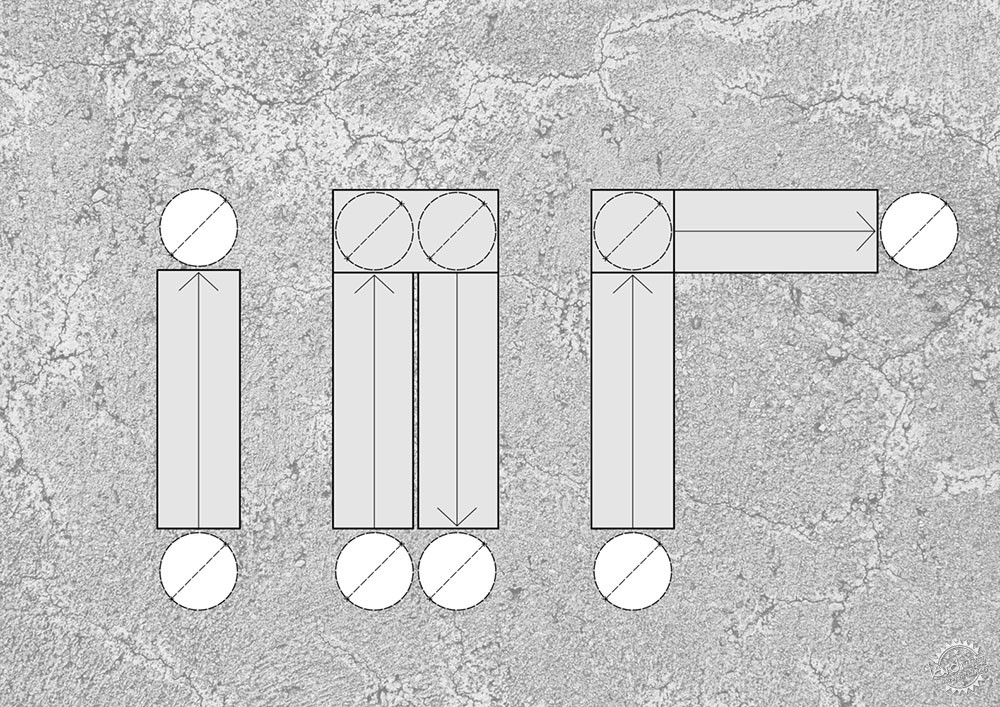
© Fabián Dejtiar
应该怎样设计扶手?
坡道必须设置有连续的扶手,两侧均不出现间断,并且要设置有两个不同的高度,其中之一的高度在65厘米至75厘米之间,另一高度则在90厘米至100厘米之间。另外,在坡道的末端,扶手也必须向前延伸30厘米,这样方便人们来到水平面。同时,扶手的下端必须固定,且所选定的材质尽量稳定,不能因为气温而产生明显的变形,这主要针对极热和极寒的天气状况。
除了扶手之外,设计时也应当考虑坡道周边的防滑措施,来避免轮椅、婴儿车、拐杖等辅助物件的滑动,或者通过明亮色调来提醒视弱人群注意脚下。
如何确定坡道的宽度?
根据规范要求,我们会发现坡道的建议宽度一般为1.2米,因为这个宽度能够让轮椅顺利地通过,并且在单人时,人与两侧扶手之间能保持180厘米的空余空间。如果坡道的宽度超过1.8米,那么最好在坡道的中央再设置一列扶手。
在确定坡道宽度时,最先考虑的应当是轮椅和婴儿车的通行空间,尤其应当注重坡道与坡道之间的水平区域。
哪些材质适用于坡道?
坡道的材质应当在干燥或潮湿的天气状况下都具有防滑功能。
另外,在坡道的起始点,都应该设计亮色区域,来提醒视弱人群注意脚下。该区域的面积不得过小,应该延伸向坡道以外至少2米。
请注意,本文给出的是坡道设计的部分建议。因为坡道的设计必须结合每个项目与场地的特殊状况,并且综合当地的法律规范,以及其它专业人员进行综合考虑。
What considerations exist for handrails?
Ramps must have continuous handrails—without interruptions—along their entire length, on both sides, and with different heights, ideally one between 65-75 cm and another between 90-100 cm. In addition, it is necessary that the handrails extend at their ends more than 30 centimeters so that anyone can reach it from the horizontal plane. They must be built in a fixed position and with smooth materials that don't change with temperature variations (imagine a handrail exposed to the sun throughout the day or in areas that experience freezing temperatures).
Leaving aside handrails, we can't forget that there is also a protective element on the perimeter of the ramp that exists to avoid any accidents on the clear edges, both by the sliding of wheelchairs, baby carriages, canes, or to warn people with reduced visual capacity.
How do we determine the width of a ramp?
Depending on local regulations, we find recommendations that range from a clearance width between handrails of at least 120 centimeters, as it comfortably allows the passage of a wheelchair and enables anyone to hold on both sides and a minimum clearance width of 180 centimeters for public spaces. In cases where a ramp width exceeding 180 centimeters is required, it would be appropriate to place an intermediate handrail that meets the above requirements.
When determining the width of a ramp, it is important to consider the maneuvering space of both a person with a wheelchair and a person with a baby carriage, mainly as a function of the intermediate breaks.
What materials can be used to construct a ramp?
Outside of any material used for the structure, the finishing materials of the ramp should use those that result in a hard non-slip surface that can be used in dry or wet conditions.
In addition, at the beginning and end of the ramp the horizontal surface there should be a tactile pavement, with different colors extending along the entire width of the ramp, to serve as a warning for people with reduced visual capacity. This same type of prevention should highlight the perimeter where the ramp opens, up to at least two meters clear of the passage.
We want to clarify that what is presented in this article is auxiliary information for the design of a ramp. All considerations for the construction of a ramp should always consider the specific characteristics of each project and should be prepared after evaluating the local regulations and according to the decisions taken by architects and/or professionals in the area.
|
|
